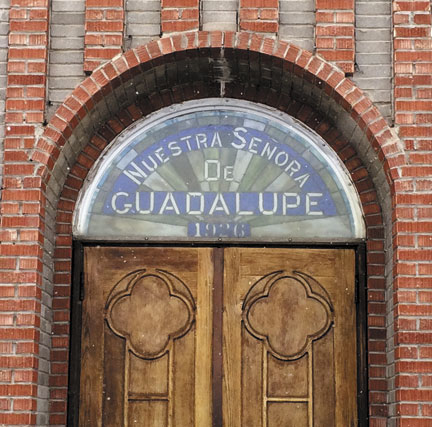By Daniel Smith
Nestled in the historically important San Luis Valley, the town of Conejos is the home of one of the early settlements in Colorado, dating back to the 1850s, and a religious treasure with a history appropriate to look back on at this Christmas season.
Folk legend tells of a stubborn burro which caused the first Catholic parish to be established along the Conejos River – yes, a burro.
Our Lady of Guadalupe Church is a picturesque edifice in Conejos, beloved by the community and well taken care of over the decades.
It was fairly recently the scene of a fire, and a sign left after the fire some of the faithful considered a miracle – more on that later.
First, some history, as outlined in local accounts and in booklets provided by the church.
The old legend says that as Spanish pioneers were making their way through the territory in the valley, they had trouble, not surprisingly, with one of the mules in their pack-train, who stopped, then was unwilling to move.
According to the story in one booklet, “persuasion, threats, beatings, all were of no avail to make the mule proceed.”
In the mule’s pack (perhaps they were taking the pack off) was found a small statue of Our Lady of Guadalupe, it was reported.
The Spaniards, the booklet’s account claims, declared that this must be a sign that the Blessed Virgin must want a church built in her honor, dedicated to Our Lady of Guadalupe – on that spot. The legend says when the Spanish vowed to build a church in that exact location – the mule, “balked no more and went jogging along with the rest of the mule train.”
The tradition says the promise wasn’t forgotten by the settlers – the men later came in greater numbers and there built an small adobe church dedicated to Our Lady of Guadalupe, though it was moved after the river flooded.
Our Lady of Guadalupe is a universally known story from Mexico among the faithful.
In 1531, legend says the Virgin Mary appeared to an indigenous man, Juan Diego, near Tepeyac Hill, now a Mexico City suburb, and asked that a shrine be built in her name there. Juan Diego reported the miraculous apparition to the local bishop.
The story says the skeptical bishop demanded to be given a convincing sign before he could approve any church construction. The Virgin appeared to Juan Diego a second time, on Dec. 12, and ordered him to collect roses in his cloak, known as a tilma’tli, which he did.

The tradition says when Diego brought the roses to the bishop, he opened his cloak and dozens of them fell to the floor, and revealing a detailed colorful image of the Virgin imprinted on the inside of the man’s rough cloak. The church was built, and the cloak with the image is revered and displayed at the Basilica de Guadalupe in Mexico City today.
Pope John Paul II made Juan Diego the first indigenous American saint in 2002 and declared Our Lady of Guadalupe patroness of the Americas. Dec. 12 became a national holiday in 1859 and each year on that day, tens of thousands gather at the Basilica to honor her.
After historic land grants and the end of the Mexican War in 1848, settlers from New Mexico were drawn to the area. The town of Guadalupe, Coloroado was established on the banks of the Conejos River around 1854 and parish priests traveled long distances from the south to minister to the inhabitants.
To clarify, the historic mission church at San Acacio outside of San Luis is technically the oldest church building in Colorado; Our Lady of Guadalupe had two destructive fires in the past and was rebuilt after each. So it is the oldest established Catholic parish in the state, though San Acacio is the oldest church structure.
In modern history, this parish has had several milestones and the community has overcome adversity at least twice.
The first devastating fire occurred on Ash Wednesday in 1926 and the church was rebuilt and expanded.
[InContentAdTwo]
Our Lady of Guadalupe was in the news more recently over a fire as well – it occurred in 2016, on the same date as the more historic fire, coincidentally, and did much damage to the interior. It was thought to have been caused by an electrical malfunction.
What some consider a miraculous sign was noticed by the faithful after the blaze. Above the main altar is a large depiction of Our Lady of Guadalupe. The soot from the fire deposited above this painting, and inexplicably collected in the shape of a multi-pointed crown just above the virgin’s head. The image of the crown was left in place in the church after repairs, cleaning and painting.
Pastor Sergio Robles has headed the parish now for nine years, and is proud to note the Our Lady of Guadalupe community numbers some 450 parishioners.
The church provides catechism instruction each Sunday morning, Robles said, and provides two Sunday masses October to May, which includes a 7:30 a.m. and 11 a.m. mass in Conejos as well as a 5 p.m. Saturday mass in nearby Antonito.
The interior is impressive; there are historic paintings and hangings decorating the walls, including a large folk art carving of Christ on the cross done by Carlos Atencio of San Luis and a tall, ornate altar space.
Fr. Robles expressed his gratitude for the volunteers who perform duties such as reading parts of the mass and the mayordomos (caretakers) who prepare the church for services and celebrations and provide food for events such as the feast of Our Lady of Guadalupe, being held this year on Dec. 8, 9 and 10 at the parish.
While the future seems secure for the oldest parish in Colorado, the community has one new concern; the repairs and cleaning and painting after the 2016 fire also revealed leaks in the old roof and it will need to be replaced at an estimated cost: of $65,000.
The Our Lady of Guadalupe parish has already begun to organize fundraising, and will accept donations at P.O. Box 305, Antonito, CO 81120.
GETTING THERE:
Take U.S. Highway 285 south of Alamosa, past La Jara. Just north of Antonito, after crossing the Conejos River, turn right onto County Road G6. The church is at the intersection of G6 and County Road 13.


